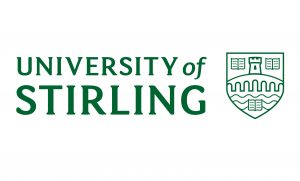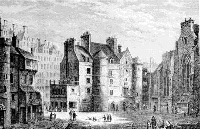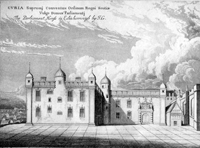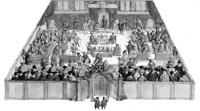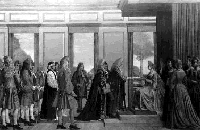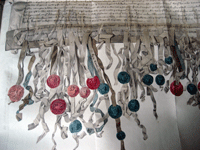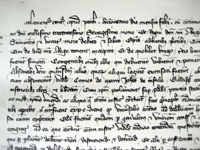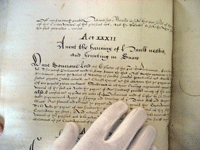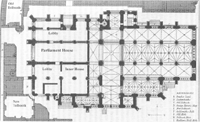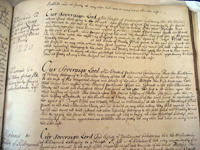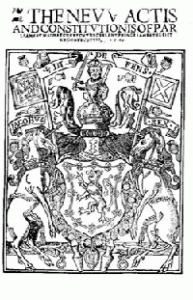
Parliament Acts 1540The title page from the first printed edition of the acts of parliament produced in 1542 and printed by the royal printer of Scotland Thomas Davidson. The statutes are those of the preceding 1540 parliament under James V. It would be the 1560s before an edition was printed which covered all legislation going back to 1424 and James I. The playwright Sir David Lindsay of the Mount, Lyon King of Arms, may have designed the woodcut. |
Edinburgh TolboothParliament met at a variety of towns and places before the 1630s, but its most common venue was the Tolbooth of Edinburgh, normal home of the town council, burgh court and chief prison of the capital. The above engraving from the eighteenth century/early nineteenth shows the Tolbooth to the north of St. Giles Cathedral by which time it was merely a prison. The building, considered to be an eyesore, was destroyed in 1817, although the position of its front door (visible in this picture) is still marked by the ‘Heart of Midlothian’, a pattern of stones in the pavement by the cathedral. |
Parliament HouseThe parliament at last had a permanent home with the opening of the Parliament House which was begun in 1632 and completed in 1639. This building still survives, though not much of the grand courtyard to the east, and has since 1707 been the home of the Court of Session, the Parliament Hall forming a grand lobby for the court. The above engraving was completed by James Gordon of Rothiemay (1615-86) shortly after the building was completed. To the right can be seen the great door of parliament at which proclamations and summonses were read. |
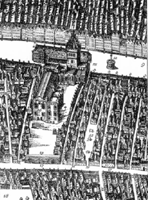
Plan of EdinburghThe above plan of Edinburgh, penned by James Gordon of Rothiemay in 1647, shows St. Giles Cathedral sandwiched between the Tolbooth to the north and the Parliament House to the south running at right angles to the cathedral. |
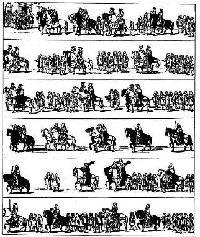
The Riding of ParliamentThe greatest ritual of the Scottish parliament was the ‘Riding of parliament’ in which the members moved by procession to and from the parliament whether it met at the Tolbooth or Parliament House. This illustration by Chalmers, herald painter of James VII is one of a series which captures the procession by foot and by horseback of members and their retinue making their way to the parliament of 1685. |
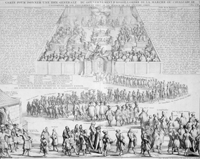
Procession into ParliamentThe above illustration taken from Nicolas de Gaudeville’s Atlas Historique (1720) shows the procession on foot to the parliament house after dismounting at the east end of St. Giles. The picture shows parliament as it would have been in the 1680s. |
Inside ParliamentThe above detail, from the Gaudeville illustration, shows the internal layout of the parliament chamber. The throne to the top centre, clergy to the left, earls and barons to the right and the shire and burgh commissioners at the back (foreground) facing the throne. |
The Act of UnionThis painting illustrates the presentation of the articles of union of 1707 to Queen Anne. [Walter Thomas Monnington ‘The Parliamentary Union of England and Scotland 1707’, oil on canvas, 1925-27, St. Stephen’s Hall, House of Commons, Palace of Westminster (WOA 2599).Reproduced by permission of the Palace of Westminster.] |
|
Declaration of Arbroath SealsThis famous document of 1320 was addressed by the Scottish political community to the pope in Rome. It was part of Robert I’s propaganda campaign to justify his seizure of the throne. Some of the seals are forgeries, in the sense that some of those shown as having ‘signed’ the document were not even present. [Image courtesy of Gillian MacIntosh from Acts of the Parliaments of Scotland, vol.1] [RPS, 1320/4/1] |
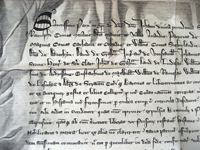
Declaration of Arbroath TextThe beginning of the famous Latin text justifying Robert the Bruce as King of Scots. [Image courtesy of Gillian MacIntosh from Acts of the Parliaments of Scotland, vol.1] [RPS, 1320/14/1] |
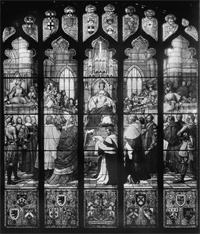
Edinburgh Parliament Hall WindowThe restored stained-glass window at the south end of the Parliament Hall. The purpose-built chamber was erected under instructions from Charles I in the 1630s.[Image from SCRAN] |
Perth Parliament TextThe estates could and did meet in a variety of burghs, especially before 1603. This act, from a parliament of David II in 1369, shows Perth as the location. The reproduction is of a page from the ‘Black Book’, an early source of parliamentary detail for the period 1357 to 1402. [Image courtesy of Gillian MacIntosh from Acts of the Parliaments of Scotland, vol.1] |
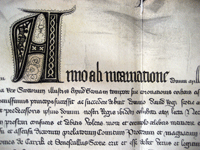
Robert II detail a (1371)The beauty of original manuscripts acts of parliament is clear to see. [Image courtesy of Gillian MacIntosh from Acts of the Parliaments of Scotland, vol.1] |
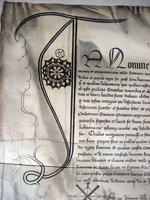
Robert II detail b (1371)The beauty of original manuscripts acts of parliament is clear to see. [Image courtesy of Gillian MacIntosh from Acts of the Parliaments of Scotland, vol.1] |
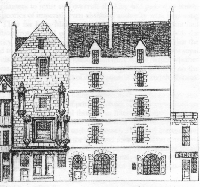
Old TolboothA sketch of the northern elevation of the Old Tolbooth, Edinburgh, before it was demolished in 1817. The estates frequently met in the older structure to the left (East) throughout the fourteenth and fifteenth centuries, probably in the ‘Common Hall’ behind the ornate square window on the first floor.[Image from Proceedings of the Society of Antiquaries of Scotland, xx (1885-6), facing p.366] |
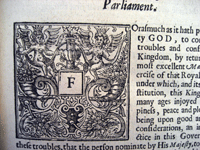
Initial LetterA typical decorative initial letter from a printing of the acts of parliament. The first printed volume of the acts was produced in 1542. [Reproduced courtesy of the National Records of Scotland.] |
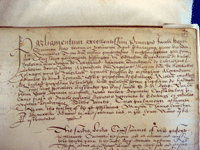
1597 OpeningThe Latin preamble recording the opening of the Edinburgh parliament of 1597. [Reproduced courtesy of the National Records of Scotland. [RPS, 1597/11/1]] |
1621 Hunting ActSince the reign of James I in the early fifteenth century the Scottish parliament attempted increasingly to control the conduct of the population, as in this act restricting hunting and hawking. [Reproduced courtesy of the National Records of Scotland. [RPS, 1621/6/44]]
|
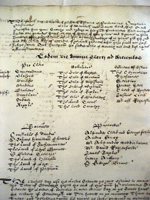
1621 Lords of the ArticlesThe committee the Lords of the Articles as constituted for the parliament of 1621, with each estate listed separately. [Reproduced courtesy of the National Records of Scotland. [RPS, 1621/6/9]] |
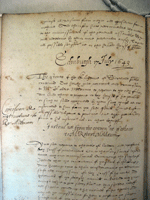
1643 InstructionsThe estates send negotiators to the English parliament to agree the Solemn League and Covenant (1643) [Reproduced courtesy of the National Records of Scotland. [RPS, 1643/6/33]] |
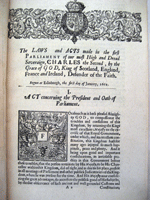
1661 Acts Concerning OathThe first act, from the printed acts, of the session of parliament in 1661 which confirms the oath that all who attended had to take. [Reproduced courtesy of the National Records of Scotland. [RPS, 1661/1/7]] |
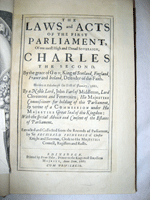
1661 Printed Title PageThe title page from the printed laws and acts of the 1661 parliament in the reign of Charles II. [Reproduced courtesy of the National Records of Scotland]. |
St Giles
A plan of St Giles Cathedral with an indication of probable internal arrangements when parliament met there, as it did frequently from 1563 to 1633. [Plan from D. Wilson, Memorials of Edinburgh in the Olden Times (Edinburgh, 1891), vol.2, p.296] |
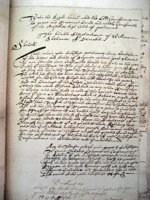
1670 Petition
A petition submitted to parliament in August 1670.[Reproduced courtesy of the National Records of Scotland. [RPS, A1670/7/7]] |
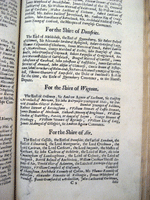
1678 Commissioners of SupplyA page from the printed session record of the 1678 convention of estates showing part of listing of commissioners of supply who had the job of ensuring that taxation was gathered in each shire, in view those for Dumfriesshire, Wigtownshire and Ayrshire. [Reproduced courtesy of the National Records of Scotland. [RPS, 1678/6/22]] |
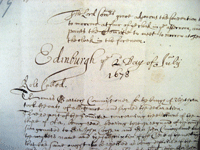
1678 Day OpensThe estates adjourn on 1 July and re-convene the next day, with the roll being called. [Reproduced courtesy of the National Records of Scotland. [RPS, 1678/6/12-13]] |
|
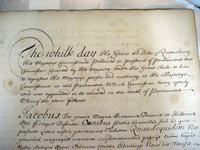
1685 Queensberry CommissionerThe parliamentary record shows William Douglas, duke of Queensberry, to be the royal commissioner for James VII at the parliament of 1685. [Reproduced courtesy of the National Records of Scotland. [RPS, 1685/4/3]] |
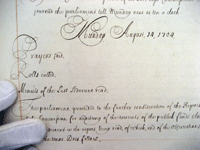
1704 Day OpensPrayers are said, the roll is called and the minutes of the previous day are read before business begins. [Reproduced courtesy of the National Records of Scotland. [RPS, 1704/7/85]] |
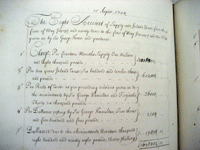
1704 Tax AccountsSome of the detailed taxation accounts approve by the parliament of 1704. [Reproduced courtesy of the National Records of Scotland. [RPS, 1704/7/89] |

